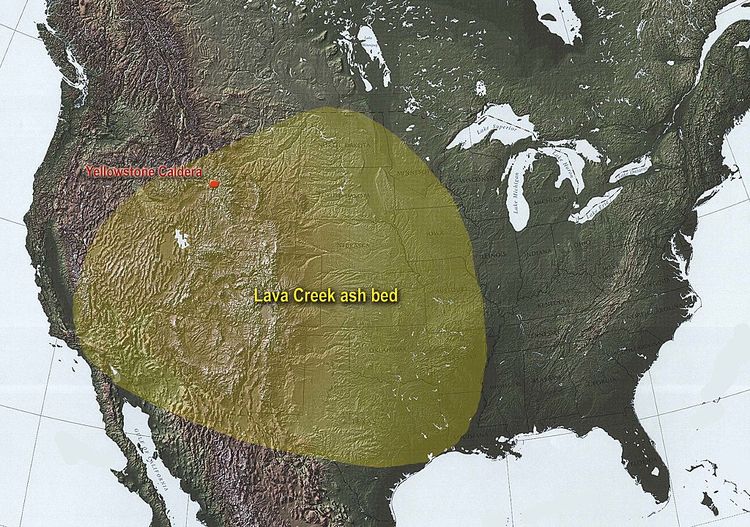https://www.realclearscience.com/blog/2019/10/10/what_if_yellowstones_supervolcano_erupted.html
What If Yellowstone's Supervolcano Erupted?
By Ross Pomeroy - RCP Staff
October 10, 2019
With its spouting geysers, majestic mountains, awe-inspiring waterfalls, and panoramic views, Yellowstone National Park has the undeniable power to uplift.
But it also has an unparalleled potential to destroy.
Concealed beneath the park rests the Yellowstone Caldera, the largest supervolcano in North America. Each year, millions of visitors trek over a massive magma chamber that, according to the United States Geological Survey (USGS), stretches from 5 km to 17 km beneath the surface and is about 90 km long and about 40 km wide. A little deeper rests another chamber that's 4.5 times larger.
The Yellowstone supervolcano has unleashed three cataclysmic eruptions in the past 2.1 million years; all well before humans populated North America. The most recent was 640,000 years ago, which formed Yellowstone as we know it and spewed 240 cubic miles of ash, rock and pyroclastic materials over roughly half of what is now the United States.

Metrodyne at English Wikipedia
So what would happen if Yellowstone erupted again?
Science writer Bryan Walsh explored the subject in frightening detail in his recently-published book End Times: A Brief Guide to the End of the World. As he described, Yellowstone National Park would literally be erased from the face of the continent.
"First would come a swarm of increasingly intense earthquakes, a sign that magma was rushing toward the surface. The pressure would build until, like champagne in a bottle given a vigorous shake, the magma would burst through the ground in a titanic eruption that would discharge the toxic innards of the Earth to the air. It would continue for days, burying Yellowstone in lava within a forty-mile radius of the eruption."
The devastation would not be restricted to the local environment. Yellowstone's plume of ash, lava, and volcanic gases would reach a height of fifteen miles or more, and from this lofty position, be blown across North America. Ash would darken the skies and blanket the ground from coast to coast, with up to three feet of ashfall in the Northern Rockies and a few inches over much of the Midwest. Citizens might be mildly amused at first at the "black snow," but they'd soon realize the danger it presents. Walsh painted a bleak picture.
"Hospitals would be choked with victims coughing up blood as the silicate in the ash slashed at their lungs."
The heavy ash would collapse roofs, contaminate water supplies, down power lines, prevent air travel, and perhaps even take out electrical transformers, bringing the nation's power grid to its knees. Worse still, ashfall would likely wipe out the Midwest's crop of corn and soybeans, should the eruption occur during the grow season. Much of America's rich farmland might also be poisoned for a generation. Combine this with a likely worldwide volcanic winter, in which global average temperatures could plunge as much as 18 degrees Fahrenheit for a decade, and you have a recipe for a global starvation event that could endanger hundreds of millions of people.
"[A Yellowstone supervolcano] would be the first truly continental-scale disaster..." Walsh wrote. "In every past catastrophe – hurricanes, earthquakes, floods – most of the United States remained untouched, which meant safe parts could divert aid to and take in refugees from affected regions. But no corner of the continental U.S. would be exempt from the effects of a supervolcano."
If you want to put a dollar cost on it, "a FEMA estimate pegged the total damage to the United States from a Yellowstone supervolcano at $3 trillion, some 16 percent of the country's GDP," Walsh added.
So what are the chances that this could actually happen?
Thankfully, very low. The USGS estimates the probability at 1 in 730,000 in any given year. There's also a good chance that shifting tectonic plates in North America have eliminated the chance of an eruption altogether by forcing the magma hot spot under Yellowstone to encounter colder, energy-sapping rocks.
More good news: the USGS monitors Yellowstone closely for any signs of an impending eruption. Their precaution could alert us to such an event years in advance, which would at least grant us time to prepare.
There have been some discussions at NASA about boring into Yellowstone's magma chambers and pumping in cold water to cool the system and quell the risk of an eruption, but this plan is wishful thinking at best. Still, the estimated cost of $3.5 billion seems a pittance to the existential threat that Yellowstone presents. It might just be worth it...
